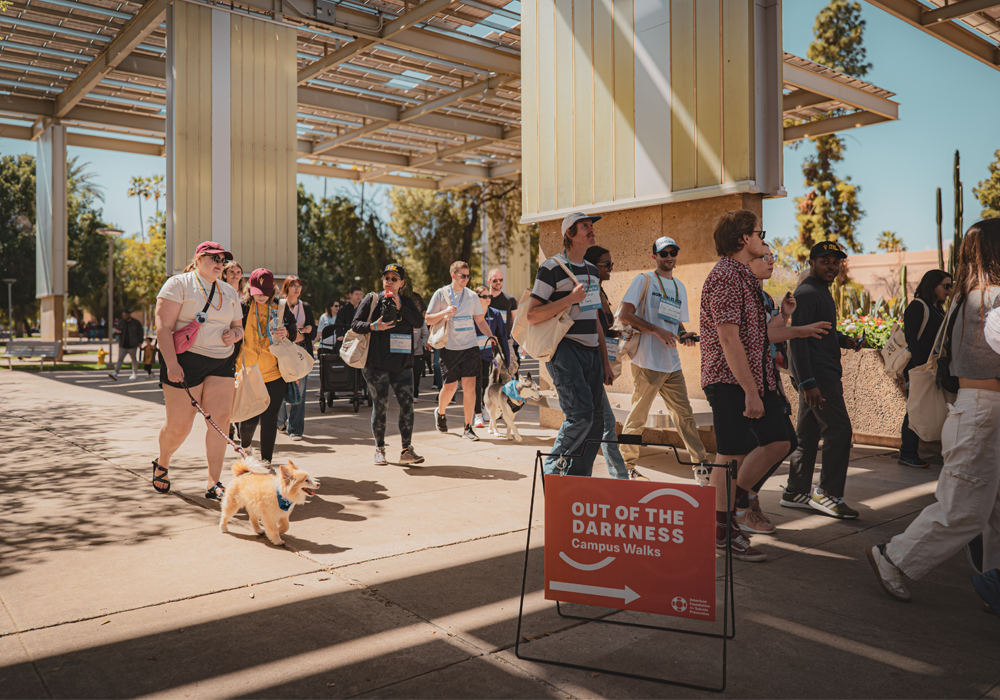Photo's courtesy of Tommy Padden
Walking Out of the Darkness together: Students and community members gather for suicide prevention

On March 16, a diverse assembly of students and community members gathered outside the Arizona State University Student Services Building. Draped in colorful beaded necklaces, they were gearing up for the yearly Out of the Darkness Campus Walk. Organized by the American Foundation for Suicide Prevention alongside Devils4Devils, Recovery Rising and the Accessibility Coalition, the event serves as a powerful effort toward suicide awareness, drawing participants from on and off campus.
Various student-led organizations and community mental health providers attended with tables full of mental health resources available to Sun Devils. Athena Garcia, the director of education for ASU’s Accessibility Coalition, commented on why they helped organize the walk.
“We are here to provide the community with resources on accessibility and to show our commitment to ending suicide,” Garcia said. “This event is critical for not only understanding what mental health resources are out there but also for connecting with clubs that support mental health and wellness on campus.”
By simply showing up, participants were able to engage in meaningful and lasting conversations about mental health and its significance.
Debbie Curtis, who introduced herself proudly as ‘Brock’s Mom,’ attended the event, with the walk being one stop on Curtis’s long trek across the United States. Having started in San Diego, Curtis plans to bike to New York City, using the momentum of her approximately 3,600-mile ride to draw attention to mental health advocacy.
“I’ll turn 62 in a few weeks, and somebody traveling cross-country on their own on a bike at my age is unusual,” Curtis said. “It’s gotten some attention, which is the point. The focus is helping young people live fuller, longer lives.”
In addition to her recently added title of cross-country cyclist, Curtis is the founder of 4TeamBrock, a family foundation seeking to provide mental health resources and education to the community. When asked about the decision to start 4TeamBrock, Curtis told Brock’s story.
“Our son passed away about three years ago from mental illness,” Curtis said. “We really didn’t know where to focus our energy when he first passed away. As I was getting closer to retirement, I knew I had to do something more meaningful.”
Mental health awareness can sometimes be overlooked, especially when students do not feel the community support around them. Curtis shared her perspective on the significance of mental health advocacy.
“Everybody looks at things a little bit differently and we all need support,” Curtis said. “I look at mental health advocacy as no different than advocating for somebody to be able to get insulin when they’re diabetic. It is a basic human right.”
When walking through the campus on Saturday, it was hard not to notice the beaded necklaces hanging from every neck, some people wearing multiple at once. Each necklace color represents a different group honored in the opening ceremony — including family and friends, members of the LGBTQIA+ community and first responders or military members, all of whom struggled with or died by suicide. Students could also wear green beads that expressed their own personal battles with suicidal ideations.
Student organization leaders stood side by side on stage at the start of the event, holding up their beads and encouraging others to do the same. In showing these symbols, all in attendance were reminded that they are not alone, no matter their connection to mental health and suicide.
As a part of the opening ceremony, Savannah Bradley shared her experience with mental health and urged all in attendance to remember the people they have around them.
“In 2016, I was hospitalized for suicidal ideation,” Bradley said. “I had a plan, a suicide note, and I was ready to leave. From the outside, everything was going great. I want to share my story with you all today because I want you to know there is a way out of the darkness. I went from a scared 16-year-old, ready to end it all, to a 24-year-old PhD student who is excited to see what the next day is going to bring.”
Outside of the colorful bead display, participants were given blank stickers to write down the names of who they were walking for. Some people wrote specific names of their loved ones, and others wrote that they were walking for themselves, sticking it to their clothes and carrying them throughout the walk.
306 people participated in this year’s Out of the Darkness Walk, as well as 24 teams, for a total number of 55.86 miles walked to prevent suicide. ASU raised $19,610.57 for the cause, surpassing the initial goal of $15,000.
Rowan Bradley, a student in attendance at the Out of Darkness Walk, shared why she thinks others should attend next year.
“So many people are afraid to come forward and ask for help,” Bradley said. “They are worried it might impede their future. But there is nothing more important than your health, and emphasizing that and providing resources that can help and that won’t derail your life is very important.”